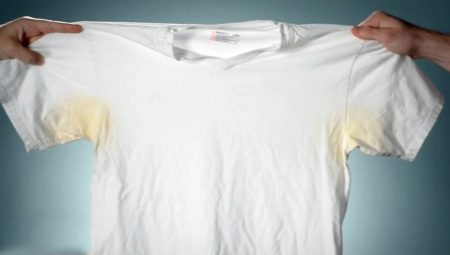The emergence of effective means of combating the smell of sweat and excessive sweating - antiperspirants, regular and perfumed deodorants, has successfully resolved the issue of masking the unpleasant smell of sweat gland secretions. But another problem arose - the use of deodorizing agents, no matter how high-quality they are, provokes the formation of unaesthetic spots on things in the armpits. Virtually every self-respecting household chemical manufacturer promises to destroy this kind of pollution and quickly return his attractive blouse or shirt to an attractive look.
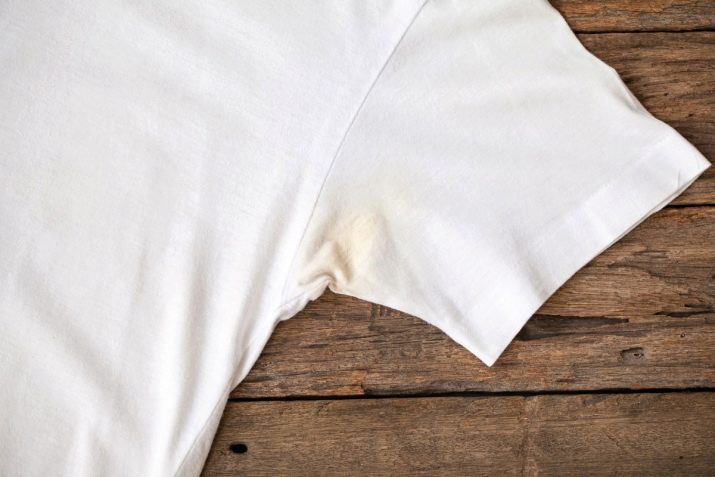
Every day we are offered a wide variety of cleaning products with revolutionary formulas of active oxygen as a washing catalyst, an antibacterial effect without chlorine and harmless surfactant analogues. All this is good, but do not forget about the possibilities of time-tested means, perfectly coping with the removal of treacherous traces of sweat and stains from de-sticks and gels. Let's talk about how to remove stains on clothing in the armpit area and what are the most effective cleaning methods.
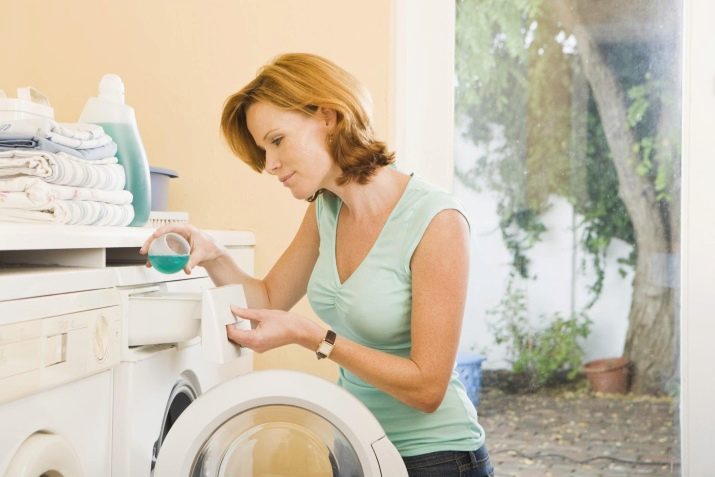
Causes of occurrence
Sweating for a person is an absolutely normal process. When the sweat glands (pancreas) are working, this indicates the metabolic processes occurring in our body. The amount of pancreas is about 2.5-3 million. They respond to thermoregulation and are involved in the elimination of toxins.
How much sweat smells depends largely on personal hygiene, which also involves the use of antiperspirant deodorants.When deo-agents come into contact with sweat, and their greatest concentration falls on the armpits, the clothes in this place are often covered with ugly stains and stains.
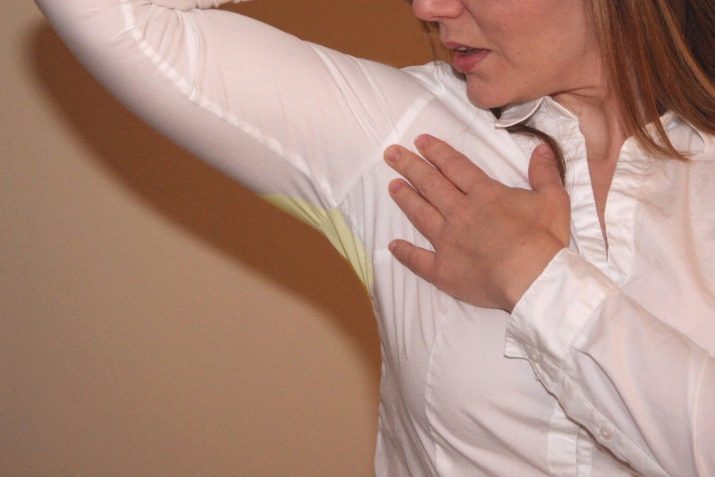
The most common triggers of this unpleasant phenomenon:
- The zinc content in the overwhelming majority of deodorizing agents for sweat - they are the reason No. 1 for the appearance of yellow spots. And many deo agents cause abnormal sweating in people with allergies or with individual intolerance to the components of caring cosmetics. The conclusion is obvious: the more sweat, the more intense the color of the spots.
- Sloppy, that is, banal neglect of hygiene or improper compliance with the rules for keeping the body clean. Yellowness in the armpit region is often formed as a result of the vital activity of bacteria and fungi, and sweat for them is an object of increased interest, since it is a favorable environment for active reproduction.

A rather rare cause of "stain formation", but it also cannot be ruled out - chromidrosis (chromohydrosis). This is a manifestation of any pathologies in the body in the form of colored secretions produced by apocrine glands. Due to the activity of microorganisms inhabiting the skin and sweat glands, sweat acquires yellowish, greenish, reddish hues. Regardless of the absence or presence of diseases accompanying chromidrosis, it provokes a peculiar color of bilirubin.
It is secreted by the sweat glands of those who live in areas with an ecologically unfavorable environment or work in hazardous industries.
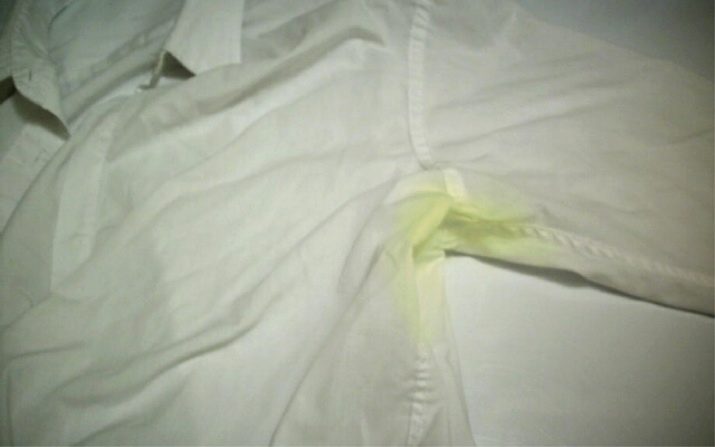
General rules
Here are a few general recommendations regarding measures to clean clothes from contamination, the origin of which is associated with the physiological process of sweating.
What is important to know:
- New methods for stain removal are tested as follows: a small area of matter is processed in the most “inconspicuous” place. If the tissue is damaged, the defect will not be evident.
- When stains are removed, the wrong side of things is always processed, especially if potent substances are used.
- Strong mechanical effects on the stains in the process of cleaning fabrics are unacceptable. Increased friction and compression can disrupt the structure of the fibers of matter, as well as provoke the destruction of coloring pigments in the deep layers of the fabric, which will lead to loss of color in this area.
- The main condition for removing sweat marks on clothing made of white fabrics is the use of a working solution of acceptable temperature up to 30 ° C. Hot water treatment will fix the stain even more, making it difficult to remove. Exposure of matter to heated air from an electric dryer will increase odor.
- When working with chemicals, it is important to use rubber gloves to protect the skin and to observe personal hygiene.

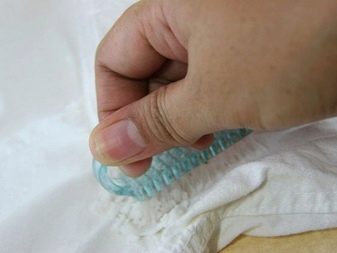
Prohibited Means
Immediately clarify the question of which cleaning products should be discarded when removing stains in the armpits. Unless, of course, intentional damage to things is not included in your plans.
So, for sweat stains it is contraindicated:
- Contact with any kind of chlorine bleach, and it doesn’t matter what things they should wash - colored or white. As a result of a chemical reaction, in which chlorine and proteins contained in the secretions of sweat glands are involved, textiles darken, and problem areas acquire a more intense color.
- On silk products - methanecarboxylic acid (acetic essence) / acetone.
- On synthetics (acetate silk, nylon, kapron) - the use of gasoline, substances containing impurities of gasoline, acetone and acetic acid.
- On cotton fabrics - treatment with strong acids (oxalic, hydrochloric), which destroy matter, and oxidizing agents.
- On linen fabrics - the use of strong inorganic acids and soda.
- On things made of natural wool - the use of alkaline solutions, including diluted, as well as oxidizing preparations.
- On colored things - interaction with the simplest representative of ketones - acetone (propanone-2). Acetone is one of the provocateurs of bleaching tissue.
In addition, be sure to pay attention to the labels on the clothes. On them, as a rule, all information is indicated that will help not to spoil the thing after washing.
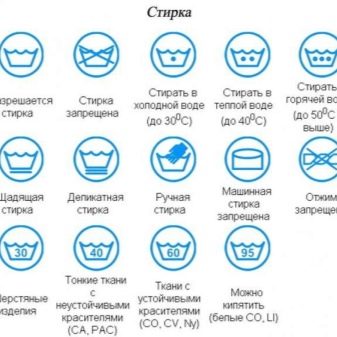
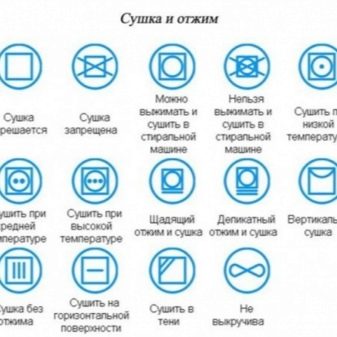
We get rid of pollution of different colors
The possibility of using these or other means for removing sweat stains is determined primarily by the color of the clothes. Things from fabrics of different colors react differently to the processing with the same drugs. What is suitable for white matter may be completely unsuitable for black, not to mention capricious colored fabrics. In addition, when choosing a cleaning method, the color of the spots themselves is taken into account.
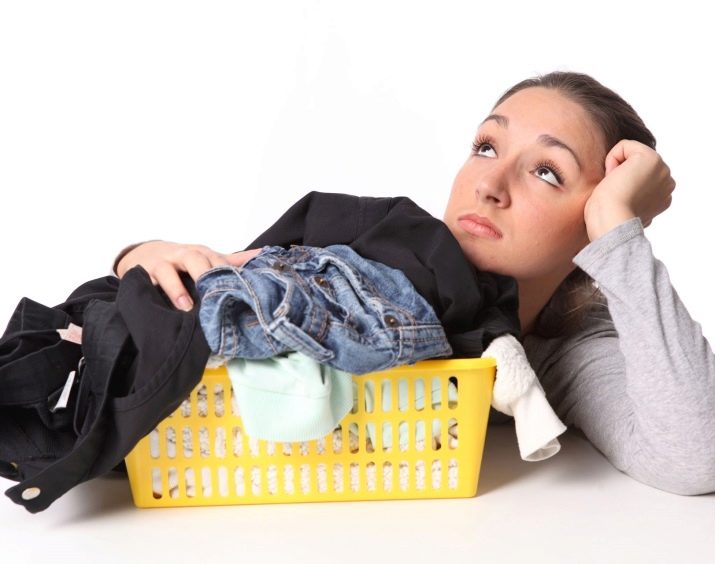
Yellow
Many of us, perfectly aware of the complete impracticality of bright things, continue to wear them. After all, resisting white magic is quite difficult. How attractive white blouses and shirts look, the same disgusting sight is the contrast of yellow spots from sweat and snow-white fabric.
Since the fight against sweat stains on light clothing has been going on since those times when there were no progressive stain removers at the disposal of housewives, this kind of pollution was removed with improvised means.
And with their help it was possible to achieve an excellent result.

You can remove fresh yellowness in the following folk ways:
- Soda. The recipe for a cleaning mixture: water (30 ml) + soda (90 g). After processing, the clothes are kept for a couple of hours and washed at a temperature of 15-20 ° C.
- 9% acetic acid. Make a working solution: water (1 l) + 9% vinegar essence (15 ml), stain is moistened, and then the thing is washed in the usual way.
- Peroxide. A solution for soaking is prepared: 3% peroxide + water (1 l) and the product is left in it for half an hour.
- Acetylsalicylic acid. Aspirin (1 g or 2 tablets) is ground to a powdery consistency and dissolved in water (100 ml). The resulting mixture should look like thick sour cream. It is applied to problem areas and kept for 3 hours.
- Common salt. Recipe for a cleansing extract: water (200 ml) + salt (30 g). Treat contaminated places, leave for a couple of hours.
- Citric acid. Spray recipe: water (200 ml) + citric acid (30 g). Spray in the yellowness area, wash after 2 hours. Laundry water should be cool.
- With ammonia and salt. Dissolve salt and ammonia in water, treat the stain, wait half an hour and wash.
- Laundry soap with oxalic acid. A powerful bleach recipe: soap shavings (½ cup) + water (200 ml) + acid (15 ml). Apply to the problem area, after 10 minutes, rinse the product, and then wash it.
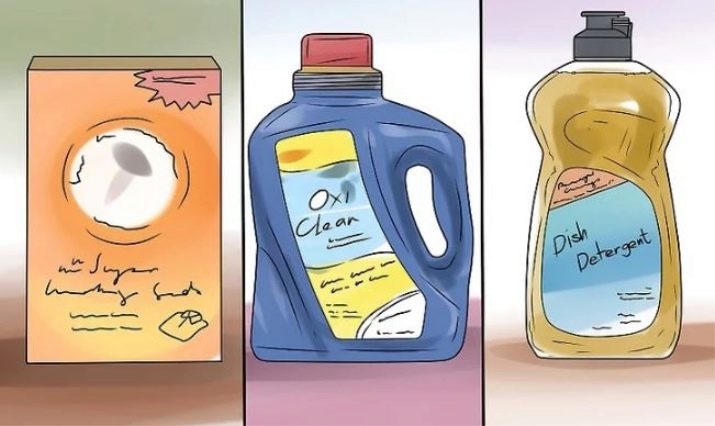
Do not neglect traditional boiling, especially when you need to get rid of sweat under the armpits on shirts and blouses made of cotton or linen. In order to maximize the effect of boiling, add ½ cup of soap shavings to the tank with things. The optimum boiling time is 3 hours. It is important to maintain a slow fire and do not forget to periodically stir the laundry.
The effectiveness of these funds as stain removers applies mainly to natural fabrics. Folk processing of lace, chiffon, viscose and similar delicate fabrics is undesirable. It is better to entrust things from them to oxygen bleach without chlorine or the well-known Fairy, only necessarily transparent.
Preparing a working solution: 30 ml Fairy + water (18 ml or 1 tbsp) and applied to the stain. After a couple of hours, things are washed.
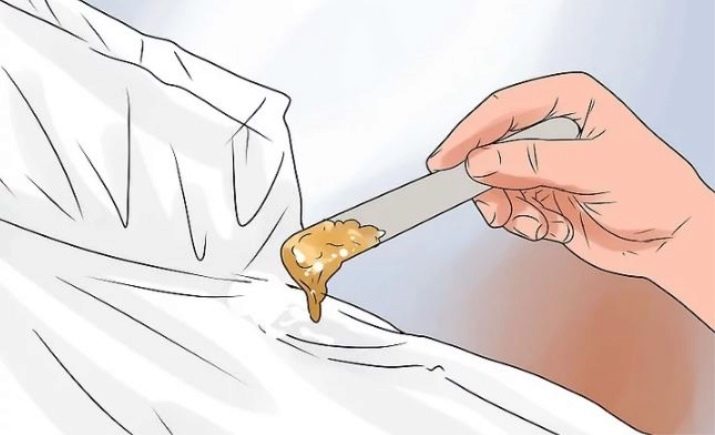
Old yellowness has to be removed by combining various methods:
- Soaking in a solution of soap chips + treatment with crushed aspirin gruel + washing + half-hour soaking in peroxide + re-washing.
- Half-hour soaking in a solution of 9% vinegar essence (dosage: water 5 l, vinegar 30 ml) + ammonia treatment + rinsing + lemon juice treatment and 2-hour soaking + washing with ordinary powder.
- The use of gasoline + ammonia treatment + 2-3 machine wash cycles to remove specific odors.
- Processing with a mixture of egg yolk and methylated spirits. The product is left until a characteristic crust is formed, then heated glycerin is applied and washed as usual.
- To wash old spots on the armpits, use the combination: soda + 3% peroxide + detergent. A mixture is prepared from these ingredients, dirty places are treated, left for 2 hours and rinsed well

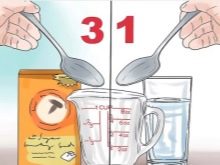
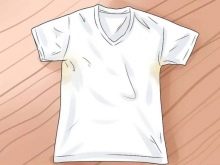
Whites
The appearance of sweat stains spoils the appearance of both white things and colored ones. Only on light tissue, sweat is manifested by yellowness, and on colored matter - by white stains. If ordinary washing removes fresh stains, then old pollution covered with a coating of salts of deo agents must be removed with more radical means. Traces of deodorant on things are well cleaned with alcohol. You need to moisten a cotton pad in it and gently rub the area of the stains.
Other cleaning methods involve processing:
- Liquid for dishes: holding time - an hour, then the product is washed.
- 9% vinegar essence: exposure time - 10 minutes.
- Citric acid - wait until the reaction begins, and wash.
- With ammonia: holding time - no more than 2-3 minutes.
- Baking soda / table salt: exposure time - half a day.
Professional stain removers are used strictly following the manufacturer's recommendations.

Dark
Wearing dark clothes is also not a panacea for the formation of sweat marks in the armpits. For cleaning brown and black things, the same methods are suitable as for products made of colored fabric. The main guideline when choosing the appropriate method is the type of matter.
What methods are recommended to process dark clothes:
- From wool - soap shavings, sodium thiosulfate (30 g per 200 ml of water), a mixture of acetone + ammonia + methylated alcohol in a ratio of 3: 2: 4.
- From cotton / flax - diluted ammonia, a mixture of ammonia and salt.
- From silk / satin - with warm saline, a mixture of ammonia + white spirit at the rate of 1: 2, a solution of sodium thiosulfate more gentle action.
- From the skin - sodium chloride, ammonia solution.
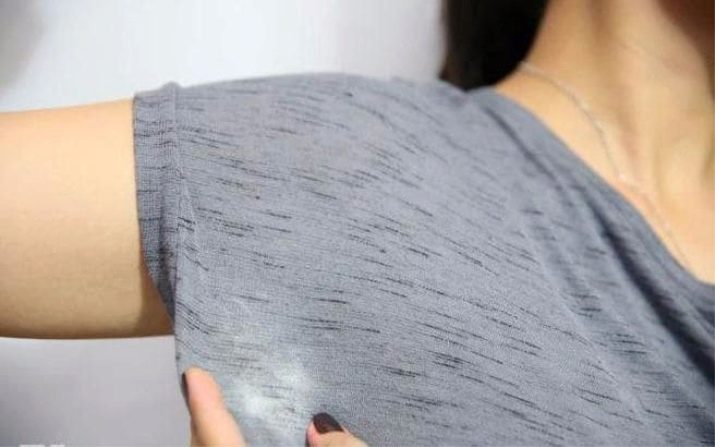
How to remove the smell?
There are several ways:
- To remove sweaty odor from the clothes, the processed and washed product must be ironed with a cloth moistened with vinegar, set to high temperature and using the steam function. After that, the product will smell good.
- Ultraviolet and frosty air are equally effective in removing persistent odor. After drying things in the sun during the day or on the balcony all night from the pungent smell there will be no trace.
- Before finally washing a T-shirt, jacket or shirt after treatment with stain removers, it is advisable to spray them several times with a spray with 3% peroxide, boric acid, aspirin or soda. This is especially convenient when combined cleaning methods are used. In between treatments, you just need to remember to use a spray gun.
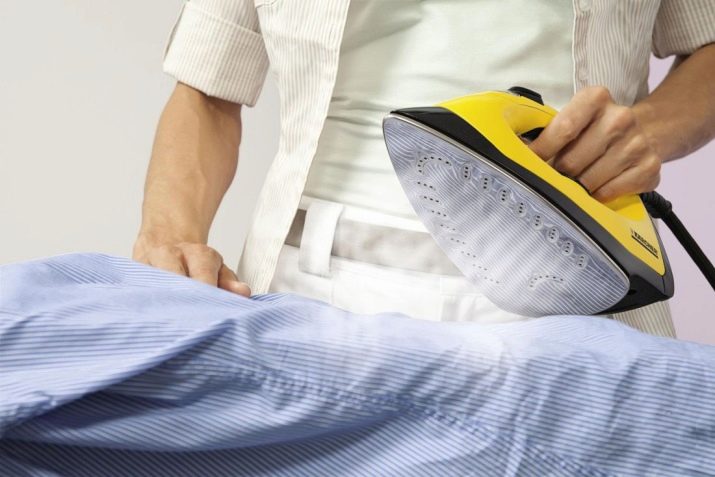
How to dry?
Heating radiators and electric dryers are undesirable assistants for drying processed items. The best conditions for this are fresh air and direct sunlight. Therefore, washed products, turned inside out, better hung on the street or balcony. If you have to dry them indoors, you need to provide good ventilation.
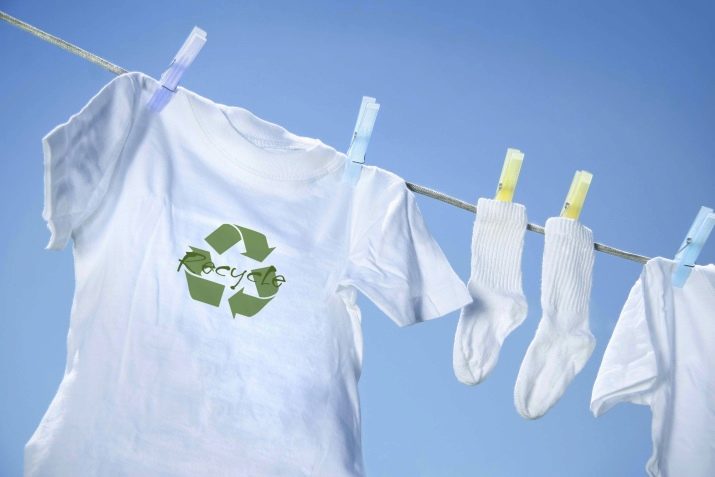
Tips
As already mentioned, increased sweating can be due to various reasons. Without taking into account the disease, sweat glands often work in an enhanced mode due to deodorants and their improper use.
Therefore, the indicated problem can be solved by following simple rules:
- After treating the armpits with deodorant, you need to let it dry completely, and only then begin to dress.
- Choose high-quality antiperspirants.
- Replace the usual deodorant with crystalline. Its purchase will cost more, but the effect of the application is worth it.
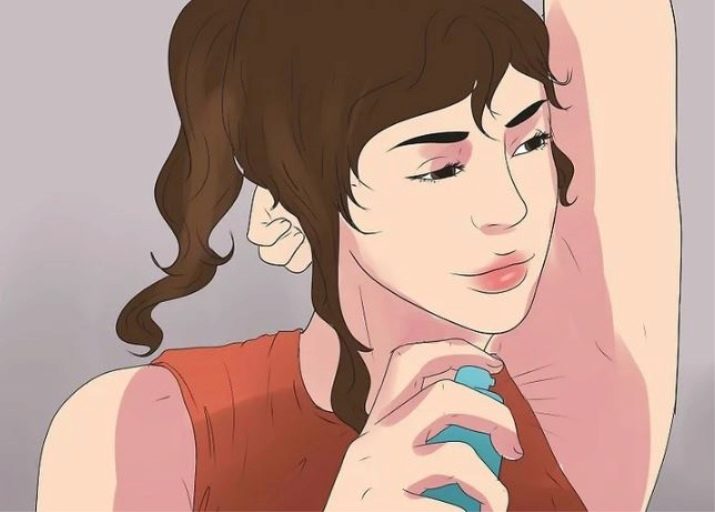
Signs of a good deo remedy:
- Provides long-lasting antibacterial protection and a feeling of freshness throughout the day.
- It has a moisturizing and softening effect.
- It has a high absorption rate.
When choosing a deodorant, it is necessary to take into account the individual characteristics of the body: the degree of perspiration and a predisposition to allergies.
Not less important:
- Wear fresh clothes every day, especially during the summer season.
- With intense sweating, put underwear under the shirts. A thin white T-shirt absorbs excess sweat.
- Get natural things. Cotton, linen and wool have good breathability.
Prevention
Of course, the formation of yellowness and stains on clothes is better to prevent than to spend time looking for a suitable cleaning product and worry about the reaction of your favorite thing to stain remover.
Prevention measures:
- The most effective sweat stain removal guide: “Never put off until tomorrow what you can do today.” The longer you pull with cleaning, the deeper the spots penetrate the tissue.
- It is worthwhile to do the washing of white things “in advance”, without waiting for the formation of yellowness. Objectively, snow-white clothes lose their attractiveness after the first two socks.
- Those who sweat a lot should buy anatomical pads for axillary hollows. They will absorb the discharge, and you will not worry about the spots.
- Depilation and epilation of armpits, daily showering, especially in the summer - all this also helps to prevent the occurrence of sweat traces.
- Increased sweating, as well as pronounced unpleasant amber, is an occasion for a visit to the doctor. If the health is normal - excellent, then it remains to simply follow the tips and recommendations given above.
For more information on how to remove stains on clothing in the armpit area, see the next video.
